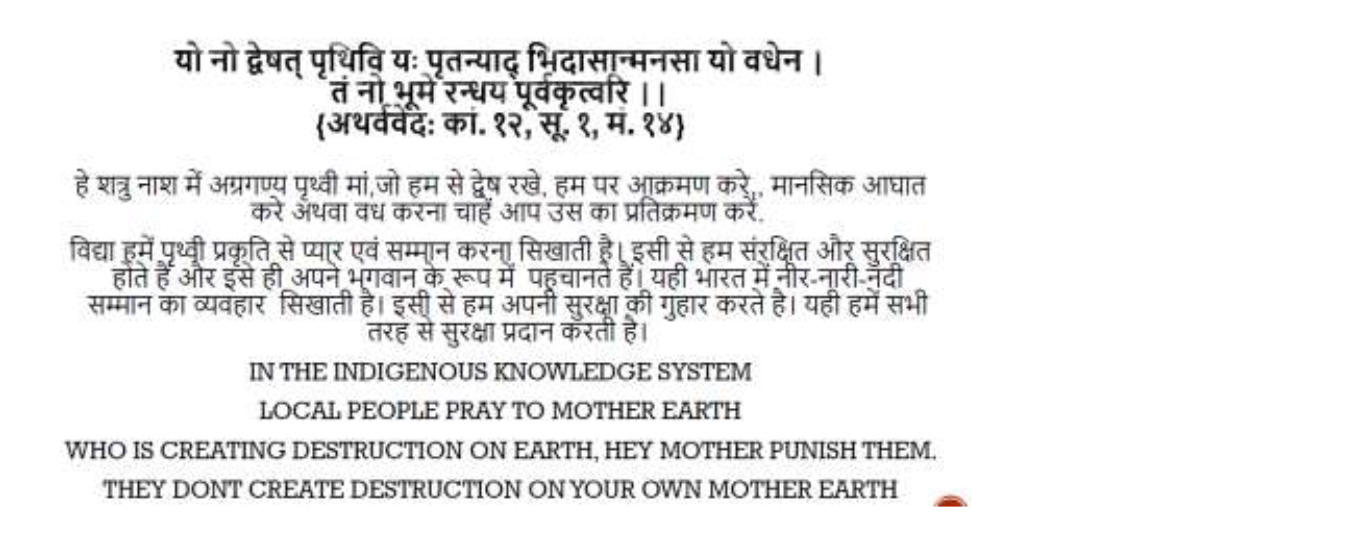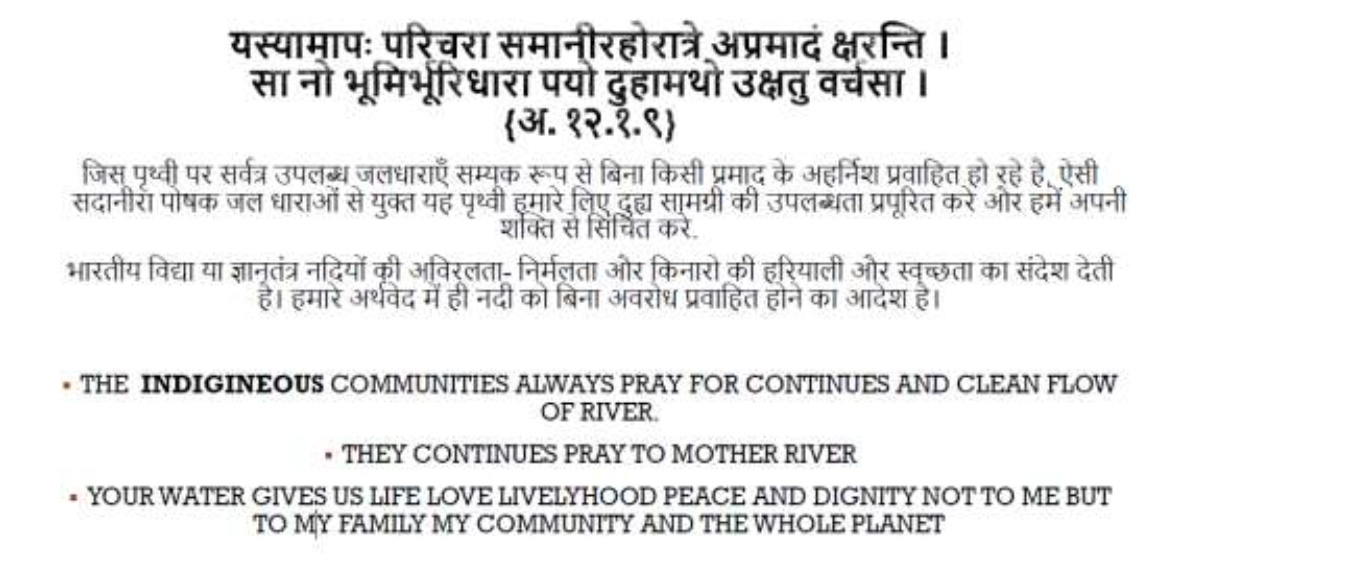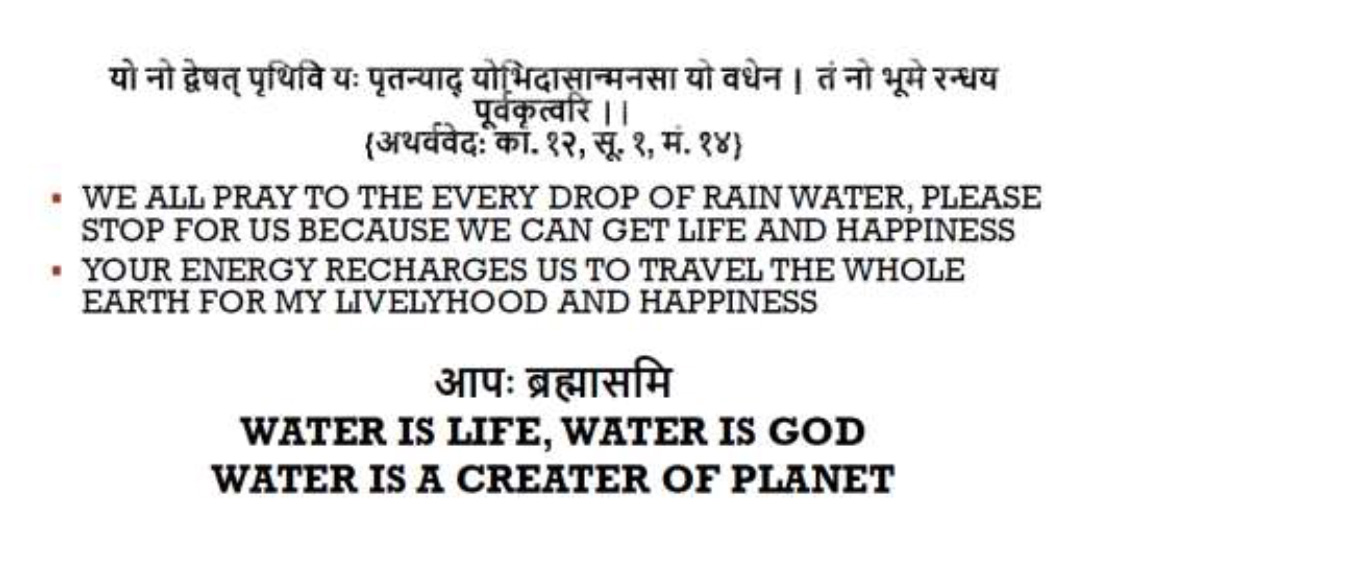Introduction
On Friday, January 19, we had a short but deeply insightful session by Dr. Rajendra Singh, widely recognized as the "Waterman of India." The session was very competently moderated by Prof R Prasad and Prof Sudhakar Rao of ICFAI.
About Dr Rajendra Singh
Dr Singh is a steadfast advocate and practitioner of water conservation and environmental stewardship. He has dedicated his entire life to addressing India's pressing water issues with a holistic and community-driven approach.
In 1985, Dr. Singh, an Ayurveda medical practitioner, arrived in Rajasthan's Alwar district. The regions faced severe groundwater depletion and the abandonment of traditional water management practices. Dr Singh established the non-profit organization Tarun Bharat Sangh (TBS). He then embarked on a mission to revive over 10,000 rainwater harvesting structures using community-driven decentralized water management systems.
Dr Singh’s’ innovative strategies include empowering local communities, emphasizing the role of women in water conservation campaigns, and instilling water literacy. Dr. Singh's efforts have gone beyond Rajasthan, encompassing projects such as the Save the River Ganga campaign.
Dr. Singh has received prestigious awards, including the Ramon Magsaysay Award in 2001, the Jamnalal Bajaj Award in 2005, and the Stockholm Water Prize in 2015. The Guardian listed him among the "50 people who could save the planet" in 2008.
Dr. Singh initiated the "Water Ethics, Justice, and World Peace Tour" in 2015, covering over 20 countries in Africa, Central and West Asia, and Europe. His commitment to nature, non-violence, and community involvement exemplifies a Gandhian ethos. Dr. Singh firmly believes that addressing water problems requires not just scientific and technological solutions but also community participation, effective policies, and local wisdom.
Dr. Singh continues to inspire a global movement towards sustainable water management. His unwavering efforts embody a profound commitment to nature, humanity, and the pursuit of a harmonious coexistence with the environment.
India’s water crisis
In India, 17 States, 365 Districts are suffering from water scarcity and drought. 190 districts have been demarcated as flood prone areas. Nowhere on Earth are groundwater declines greater than in Northern India. NASA found that large-scale irrigation caused 108 cubic kiloliters of groundwater loss in Haryana, Punjab, Rajasthan, and Delhi between 2002 and 2008. The study’s lead, Matt Rodell, observed: “The region has become dependent on irrigation to maximize agricultural productivity. If measures are not taken to ensure sustainable groundwater usage, the consequences for the 114 million residents of the region may include a collapse of agricultural output and severe shortages of potable water. "
Indeed, India grapples with a multifaceted water crisis: scarcity, pollution, overuse, and inadequate governance. This is due to a combination of factors: population growth, urbanization, industrialization, and outdated infrastructure.
Ancient wisdom
Some 12,500 years ago, the Atharva Veda had mentioned: when nature gets angry, there are floods. Indeed, the Atharva Veda gives a lot of importance to water. The Atharva Veda also recommends punishment to the wrong doers.

Water is revered as the source of all life, sustaining vegetation, animals, and humans. Verses in the Atharva Veda praise water for its purifying and invigorating qualities. A hymn to Apas (Atharva Veda 5.7) praises water for its purity and life-giving properties. It compares water to a mother nurturing her child and highlights its role in sustaining all living beings.

Water is personified as a goddess, often referred to as Apas (waters) or Varuna (the ocean god). Hymns are dedicated to appeasing these deities and seeking their blessings for abundant rainfall and clean water. The Varuna Sukta (Atharva Veda 4.16) addresses Varuna, the ocean god, seeking his forgiveness for any transgressions against the cosmic order of nature. It recognizes the power of nature and emphasizes the need for harmony with its elements.
Reviving the rivers of Chambal
Dr Singh recalled his work in Chambal where the rivers had dried up. The unemployed youth had mobilized guns and resorted to illegal mining. They also began looting in the cities. These were not criminals at heart. Out of helplessness, they were killing others and getting killed. Dr Singh worked with the community and converted these dried-up rivers into perennial rivers over a period of 12 years. Consider the two rivers, Sherni and Parvati. After the water was restored, the youth again began crop cultivation. There was no government funding. It was a completely community driven exercise. Without water, there can be no civilization. The revival of the rivers rejuvenated civilization and restored farming. The lesson is that the circular economy starts with love of nature and respect for nature.

Conserving water through water harvesting
Thanks to Dr Singh, water harvesting has been initiated and storage capacity (in 160 structures) of about 15,200 million liters has been created.
Groundwater recharge is about twice the capacity, which is also making the river flow perennially. The total harvesting done so far is about 45,600 million litres or 22.6% of the rainfall which is available for harvesting. One third of the water is stored on the surface and two thirds in the groundwater storage created.
If approximately 25% of the rainfall in the catchment area is harvested, and the groundwater storage is recharged twice, even in the most challenging areas, revival of stretches of rivers is possible within a couple of years. The entire river can become perennial within ten years and at low cost. Dr Singh’s methods are very cost effective. The cost per kilo litre of storage created is Rs 4-6. This is affordable even for marginal communities with minimum support from outside.
Shishya vs Vidya
Dr Singh drew a distinction between Shiksha (formal education) and Vidya. Shiksha has led to self-disintegration. We need Vidya to take us forward. We have to integrate Shiksha and Vidya. Education makes us think with our head. But we do not consider the soul. (Knowledge acquired by formal education alone is not true knowledge. It increases pride, which is a hindrance to personal growth. When a person accepts the knowledge of the senses as the only knowledge then something is missing. When the knowledge of the senses dissolves in the intellect, then the mind is pure and Shiksha becomes Vidya.) People who live with nature love nature. If we love nature, we will move to Vidya.

The Panchabhootam
We must appreciate the Panchabhootam, i.e. the five fundamental building blocks of all existence. These elements are:- Prithvi (Earth): Represents solidity, stability, and grounding. Associated with the sense of smell.
- Apas (Water): Symbolizes fluidity, adaptability, and emotions. Linked to the sense of taste.
- Agni (Fire): Embodies transformation, energy, and passion. Connected to the sense of sight.
- Vayu (Air): Represents movement, breath, and communication. Associated with the sense of touch.
- Akasha(Space/Ether): Symbolizes vastness, potential, consciousness. Linked to the sense of hearing.
The Panchabhootam are not just physical elements, but rather subtle forces that permeate all aspects of reality, including the human body and mind. Their harmonious balance is essential for physical and mental well-being.
There was a time when we respected these 5 elements. We believed in: Nar Nari Nadi- Narayan. We were respected as global leaders.
We must regain our ancient glory. We must allow water to flow freely. Water provides medicine and nourishment. Water is life. Water is God. Water creates the planet.
Dr Singh has constructed some 14 800 dams. These have recharged some 250,00 water points. About 12.5 lakhs displaced youth (including some 2700 who had resorted to guns and warfare) have gone back to farming.
Water related displacement, hatred, wars, and conflicts
When there is water shortage or flooding, people are displaced and become climate refugees. One major issue has been forced migration due to climate change. Many people from Central and Western Asia are migrating to Europe. These ‘climatic refugees’ are creating tension in Europe. India is facing a similar migration issue with people moving from rural areas to urban areas. Urbanization is not able to keep up with healthy development causing mismanagement of ecology. This is leading to hatred. Our education system has removed love for each other and nature.
When he visited the Middle East, Dr Singh gathered that on the Euphrates, Ataturk had built 6 dams. As a result, the women who had pioneered farming (since 12,000 years) were displaced. It was the displaced people of Iraq who fought with Syria. It was not a Shia Suni war as is widely perceived. The Palestine Israel war and the Sudan-South Sudan war, Zimbabwe, are also the result of water shortage.
Overdraft in underground aquifers
An aquifer is an underground layer of porous rock, sand, or gravel that is saturated with water. Aquifers are like giant natural reservoirs that store freshwater. Overdraft occurs when more water flows out of an aquifer than is replenished naturally. This can happen due to increased demand for water as populations grow and economies develop, droughts and changes in precipitation patterns and inefficient water use. When an aquifer is overdrafted, the water table (the level of water in the ground) begins to decline. This can have a number of negative consequences, including reduced water availability, land subsidence (sinking of land) and water quality degradation (salt water intrusion which makes water unusable for drinking and irrigation.) Dr Singh’s work has recharged underground acquirers, stopped evaporation, and enabled water to accumulate.
Johad Revival
Dr. Singh's signature initiative lies in reviving traditional "Johads" – earthen check dams that collect and conserve rainwater. In the drought-prone regions of Rajasthan, these ancient technologies were neglected, leading to water scarcity. Recognizing their potential, Dr. Singh has spearheaded Johad construction and repair, reviving over 5,000 of these structures across 11 districts.
The importance of indigenous knowledge
Modern science deals with concepts and numbers. Our villagers may not understand all these technicalities. But they have a grounded understanding of what is required to make the water flow. We must revive this indigenous knowledge.
Consider the city of Jaisalmer, one of the driest cities in the country. Till about 400 years back, some 1500 camels and 200 people would travel across the desert for trade each day. There was plenty of water available for them. This is testimony to the ingenuity of our locals and the power of traditional knowledge for conserving water.
We must link crop patterns with rains. Agriculture is the sector which consumes the maximum amount of water. We can cut water consumption in agriculture by 40%.
The water cycle
The water cycle, also known as the hydrologic cycle keeps our planet alive.- Evaporation: The sun's heat warms the water in oceans, lakes, rivers, and even puddles. Water evaporates and escapes into the atmosphere as water vapor.
- Transpiration: Plants release water vapor into the atmosphere through their leaves in a process called transpiration. This contributes significantly to the overall amount of water vapor in the air.
- Condensation: As the water vapor rises higher in the atmosphere, it cools down. At a low enough temperature, the water vapor condenses back into tiny water droplets or ice crystals, forming clouds.
- Precipitation: When these water droplets or ice crystals become too heavy, they fall back to Earth as precipitation. This can take many forms, such as rain, snow, hail, or sleet.
- Collection: The precipitation collects on land or in bodies of water like oceans, lakes, and rivers. Some water may soak into the ground, replenishing groundwater reserves.
- Runoff and groundwater flow: Water on the land surface may flow downhill as runoff, eventually reaching rivers or oceans. Some water may infiltrate the ground and become groundwater, slowly moving through soil and rock layers.
- The cycle continues! The water collected on land and in bodies of water eventually evaporates or transpires again, rising back into the atmosphere to start the cycle all over again.
Q&A
Water is important. We know that. Yet, we do not do much about it. How can we sensitize people?
Dr Singh emphasized that Indian people love nature and have faith in nature. It is not difficult to sensitize the youth. With 10-15 webinars, Dr Singh was able to mobilize the young people of Maharashtra. They came forward to help in rejuvenating the rivers. Then the government stepped in. They wanted to know what they could do. So, Dr Singh suggested: Why not convert some rivers into Amrit Vahini, i.e. make them fit for drinking. As part of Amrit Mahotsav, 108 rivers have been rejuvenated without taking government money. Dr Singh has focused on reviving rivers which only need natural treatment. (Those rivers which need ventilators and hence need investments have not been the focus.)
We must show love and respect for the community. We must try to understand what they want and align with their needs. We must foster belonginess and ownership. That will build faith and trust and mobilize the local communities.
Note: Throughout his life, Dr Singh has championed a community-based approach, empowering villagers to take ownership of their water resources. Through awareness campaigns and workshops, he has educated locals on Johad construction, maintenance, and water management practices. This has fostered a sense of responsibility and ensured the long-term sustainability of the projects.
Dr Singh has opposed the interlinking of rivers, right from the days of Prime Minister Atal Behari Vajpayee. Rivers have their own identity and differing patterns of water flows. If we interlink rivers without understanding the gene pool diversity, it can lead to disaster. Another complicating factor is that the center (in case of interstate rivers), states, and local governments (nagarpalikas, panchayats) have rights on water bodies. There are different interests and perspectives involved. So if we interlink rivers without deliberation or thought, it can lead to a constitutional disaster. Linking rivers is not the solution. Rather, we should link our heart, head, hands with rivers to rejuvenate them, make the water flow and keep it clean.
Dr Singh’s Tarun Bharat Sangh has globally established through its climate change work that climate is water and water is climate. This slogan was accepted and ratified by SDG 2015 and by COP 21 at PARIS.
These community driven efforts cannot create large business tycoons. That kind of material success is possible only through a violent economy. But we can certainly start living in harmony with nature and create good human beings though these sound water management practices that reinvigorate the circular economy. This is a nonviolent economy that is rooted in Sanatana Dharma. What we need is science with common sense.
Water crisis is a global problem, but the solution is local. The only way out is by imparting and exercising water ethics, justice, and peace through water literacy movement across stakeholders beginning from water conservation and its efficient use. This should eventually lead to collaborative efforts for a better common future through respect for nature. India needs community driven decentralized water management. We also need a holistic approach that integrates geo hydro morphology, technology, and engineering.
